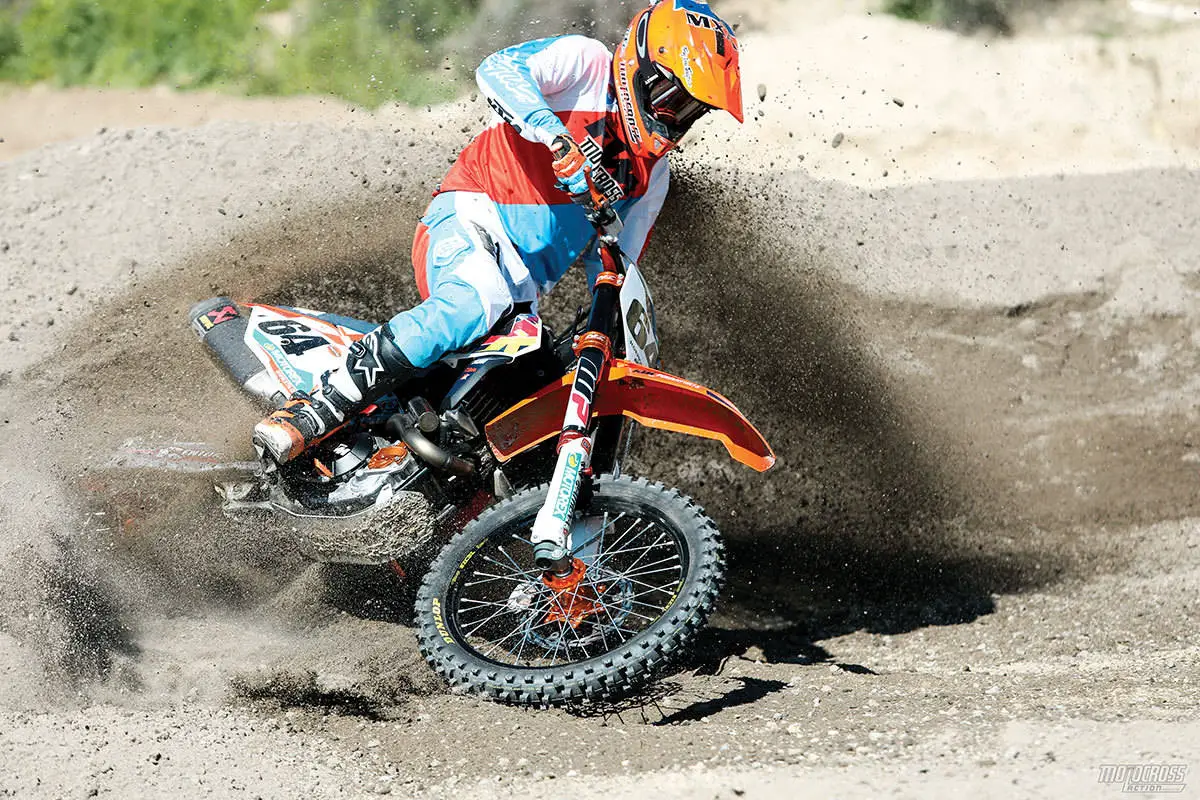FORK WORKS: 2018 WP AER CONE VALVE AIR FORKS

If you are a hardcore KTM racer, you know that the Cone Valve coil-spring forks are at the top of the KTM suspension pyramid. Cone Valve forks are supple, resilient and plush from start to finish. The downside to the coil-spring-equipped Cone Valve forks is that they are heavy. This weight differential between Cone Valve forks and AER air forks is 3-1/2 pounds. It’s not surprising that many KTM owners have asked for Cone Valve performance with AER weight.
Well, now they can get it. The WP AER 48 Cone Valve fork combines the incredible Cone Valve damping system with the AER air-spring system. One leg contains the damping, while the other leg houses the pneumatic air chamber. But, don’t think of this as a box-stock WP AER air-fork leg mated to a Cone Valve damping leg. It isn’t. Each fork leg on the AER Cone Valve is unique.
Damping leg: The Cone Valve system does not use any shims on the compression side of the stroke. It is called a Cone Valve fork because a tapered cone replaces the shim stack in the mid-speed valve. As oil flows through the mid-speed valve on compression, it pushes against the tapered cone, which is held in position by a short coil spring. The oil pressure depresses the cone’s spring to allow more or less oil to flow through the mid-speed valve. It is naturally progressive and allows the suspension fluid to flow with an almost unlimited range to reduce harshness. This is most noticeable in how well the front wheel responds to the ground when running harder settings. There are three different optional cones, each with a different degree of taper.
Air leg: Unlike the production-line WP AER fork, the AER Cone Valve fork has both a main air chamber and a balance chamber (each with its own Schrader valve). This dual-air system allows more adjustment than on the stock AER forks, which automatically transfer air pressure from the positive to the negative side. The benefit of the AER Cone Valve air system is that the rider can fine-tune ride height, air-spring preload and overall feel by juggling the relationship between the positive and negative air pressures.
THE MXA WRECKING CREW LOVES THE TRADITIONAL COIL-SPRING CONE VALVE FORK. IT IS THE BEST FORK ON THE MARKET, ALBEIT THE AFTERMARKET. THE CHOICE COMES DOWN TO THE 3-1/2-POUND WEIGHT DIFFERENCE.
The MXA wrecking crew loves the traditional coil-spring Cone Valve fork. It is the best fork on the market, albeit the aftermarket; however, the choice to take off stock WP AER air forks and mount coil-spring Cone Valves forks comes with a 3-1/2-pound weight disadvantage. Thus, the release of the all-new WP AER Cone Valve air fork was right up our alley. Because it was a new design, we had to work on our settings. There are two air pressures to set on the AER Cone Valve air forks. Each test rider worked to find the main (top) air pressure that worked best for his speed. While our Pro test riders ran 165 psi, the more we went down the skill and age level, the more we lowered the air pressure in the main chamber. There were test riders who ran as low as 135 psi. The trick to finding the sweet spot was to run exactly 10 psi more pressure in the balance chamber (bottom) than in the top. Thus, when we ran 165 psi in the main chamber, we ran 175 psi in the balance chamber. If we ran 155 psi in the main, we ran 165 psi in the balance, and so on. From that starting point, each test rider dialed in the feel, remembering that more pressure in the balance chamber softened the fork’s initial feel and made it ride lower in its stroke. As for clicker settings, we were 17 out on compression and 20 out on rebound.
What would we choose to race with? If weight were not an issue, we firmly believe that the coil-spring Cone Valve forks would be better than the air forks. No matter how you look at it, air forks don’t deliver the same feel as coil springs; however, if weight is an issue, the AER coil-spring Cone Valves win out—without a giant penalty in performance. www.wpnorthamerica.com





Comments are closed.